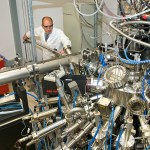energy
High-temperature superconductors (HTS), capable of storing and transmitting electricity with perfect efficiency, are a theoretical stumbling block. The mechanism underlying HTS behavior is a mystery, and the subject of significant contention and investigation among scientists. This puzzle, unlike headline-making unknowns such as dark energy (admittedly awesome and worth losing sleep over), could revolutionize our entire energy infrastructure. But before HTS materials can flood the electricity market, they need to work their magic closer to room temperature (high-temperature is a bit…
Brookhaven's Joe Gettler interviewed biologist Ben Babst about his pioneering plant biology research - here's an excerpt:
Ben Babst has seen things that no one else has ever seen before. A plant biologist in Brookhaven Lab’s Biosciences Department, Babst is among pioneering researchers who are some of the first in the world to study plants using a technique called positron emission tomography or PET imaging, which is more commonly used to diagnose cancer and study brain activity. With this innovative use of PET imaging technologies, Babst has actually watched plants shift nutrients from their…
Red pea aphids (Acyrthosiphon pisum); Figure from: Valmalette et al., 2012
In 2010, scientists at the University of Arizona showed that aphids can produce their own carotene. No other animals are known to produce this important antioxidant and must therefore obtain it from their diets. Aphids apparently acquired this ability to produce carotenoids from a fungal gene that was incorporated into their own genome at some point in evolutionary history. Because aphids were shown to produce large amounts of carotenoids, researchers Valmalette et al., wanted to know if the carotenoids…
"The colors of a rainbow so pretty in the sky.
Are also on the faces of people going by." -Louis Armstrong
It's no secret that white light is the light that we see when all the colors shine together and are seen at once. This has been known for over 400 years, when Isaac Newton demonstrated that white light could be broken up into all the known colors by dispersing it through a prism.
Image credit: Adam Hart-Davis.
All that we're doing is breaking white light -- in this case, sunlight -- up into all of its component colors. This can be done artificially (such as by configuring a prism) or…
The following article is mirrored from TomDispatch.com. I thought that while we are watching the weather heat up, we should not forget that geo-politics heats up with it.
Six Recent Clashes and Conflicts on a Planet Heading Into Energy Overdrive By Michael T. Klare
Conflict and intrigue over valuable energy supplies have been features of the international landscape for a long time. Major wars over oil have been fought every decade or so since World War I, and smaller engagements have erupted every few years; a flare-up or two in 2012, then, would be part of the normal scheme of…
With nanotechnology rapidly advancing, the sci-fi dream of a Star Trek replicator becomes increasingly less fantastic. But such radical technology would, in theory, require the kind of subatomic manipulation that far exceeds current capabilities. Scientists lack both the equipment and the fundamental knowledge of quantum mechanics (the Standard Model, for all its elegance, remains incomplete) to build items from the raw stuff of quarks, gluons, and electrons . . . but what about alchemy?
Even Isaac Newton, credited with the dawn of the Age of Reason, felt the mystical draw of alchemy,…
Building 3D images gets trickier with objects bilions of times smaller. (courtesy Electric-Eye on Flickr)
Let's start with a number, by chance a palindrome: 1441. Imagine taking that many photographs of a single object, a soccer ball, say - obsessively capturing it from every angle to expose all the details. Those 1441 images provide all the evidence needed to illustrate and understand the three dimensional structure of that soccer ball. Each shot reveals another curve of the sphere, another line in the checkered pattern, another scuff or scratch along the surface.
An adept programmer or…
Another poll shows increasing and strong interest among Americans in developing Green Technology and related technologies, as well as reduced interest in anti-environmental extremism and petrolatum-related efforts.
Previously, we discussed the new poll by the Science Debate people, and now we have new information from the UT Energy Poll.
The results are mixed, but interesting. In order of decreasing preference expressed by a voter to support a candidate for president based on their position, voters like expanded natural gas development1, incentives for renewable tech companies, increased…
On Sunday, I interviewed Maggie Koerth-Baker, the author of Before the Lights Go Out: Conquering the Energy Crisis Before It Conquers Us. The interview was live on radio, but you can listen to it here as a podcast.
Maggie is the science editor at Boing Boing, a journalist, and has had an interest in energy and the related science and engineering for some time. Her book is an overview, historical account, and detailed description of the energy systems that we use in the United States, outlining the flow of watts, CO2 emissions, methods of making more watts, what we use it all for, and more…
Richard Heinberg has a nice piece about drawing conclusions from present trends. Among his observations:
If current economic trends continue . . .
China's economy will be 8 times as big as it is today by 2040.
China's economy will surpass the size of the present global economy before 2050.
The US federal debt will double--from $14 trillion to $28 trillion--by 2022.
In 2072, the federal debt will amount to $896 trillion, or $1,629,091 for each American (assuming a US population then of 550 million).
By the end of the century, each American will "owe" over a billion dollars.
Thanks to the…
Wind power is like Ginger Rogers. You know what I mean. It isn't judged by the same standards as other kinds of electricity generation.
Click here to visit an interactive guide to wind power in Minnesota.
I'm speaking specifically of the reliability of, or variation in, wind over time. Many people live in places where they personally experience highly variable wind, or at least, think they do, so it is easy to assume that wind generators would be sometimes running on full, sometimes standing still, in a more or less random and unpredictable way, but this is not necessarily true. There are…
If you have followed energy issues from anywhere other than a cave on a mountain peak, you've probably heard technoutopians utter some variation on the following sentence two or three hundred times "We walked on the moon - of course we can do whatever it takes to shift from fossil fuels to some other source of energy." The moon shot is perceived as the ultimate example of "put in a quarter and get out the technological outcome you want" in our history. If we could set out to put a man on the moon and do it in less than decade, can't we do anything we want to, with just enough ingenuity?…
by Mark Pendergrast
This is my third and final post about the state of Japan's renewable energy efforts and other measures that are vital to prevent further climate change and to wean the country from fossil fuel and nuclear power. In my first post, I covered the public-health impacts of climate change and explained why Japan is good indicator of whether countries will be able to act quickly enough in the face of these threats. Japan's reliance on imported fossil fuels gives it a good reason to invest in alternatives, and its technological sophistication should help it develop renewable-…
by Mark Pendergrast
I'm going to talk about Japanese renewable energy in a minute, but first let me explain why.
In 2010, I published a book on public health (Inside the Outbreaks), and as a follow-up, I concluded that the overarching threat to the world's public health that we face in the coming decades is climate change, for a number of reasons. According to most scientists, three trends will conflate to create substantial problems. 1) We will run out of oil. 2) Climate change will have a profound impact on the environment and our lives. 3) The world's population will grow from 7…
This guest post was written by Pat Looney, chair of the Sustainable Energy Technology Department at the U.S. Department of Energy's (DOE) Brookhaven National Laboratory.
If the sun is shining over Long Island, NY, as you read this article, the Long Island Solar Farm (LISF) is generating enough clean solar energy to power as many as 4,500 homes for the Long Island Power Authority (LIPA).
Construction of the LISF at Brookhaven National Laboratory (BNL) began in the fall of 2010 and officially concluded this month when the array began commercial operation. LIPA hosted a formal commissioning…
From David Leonhardt at the New York Times, a good, if very partial explanation of why the overall future of the US and the Global North generally doesn't look as promising as the 30s. See if you can guess what's missing from the article.
Still, the reasons for concern today are serious. Even before the financial crisis began, the American economy was not healthy. Job growth was so weak during the economic expansion from 2001 to 2007 that employment failed to keep pace with the growing population, and the share of working adults declined. For the average person with a job, income growth…
Jason Graetz, left, and Jiajun Chen at NSLS beamline X14A with their transparent reactor for viewing chemistry in real time.
Here's a recipe for basic chemistry: Mix a bunch of stuff in a reaction vessel and see what happens. Only you don't really see the action taking place -- unless you have some way to visualize the molecular magic.
Researchers at Brookhaven National Laboratory have developed just such a technique: They've fabricated a transparent chemical reactor vessel that allows x-rays to pass through and capture the chemical changes as they take place.
They recently used this…
Perhaps the first widely read piece I wrote was entitled "Peak Oil is a Women's Issue" and focused on the ways that an energy decline might affect women. At the time it was written (the earliest version appeared in 2004) the peak oil movement was largely a group of men, mostly geologists, oil men, a few economists and journalists interested in a growing issue.
My argument (more refined variations of which I've continued making for years) was that women need to organize around energy and environmental issues, because they stand to lose a great deal in a society that has fewer resources to…
The following guest post was written by Wei-Qiang Han, a materials scientist working at Brookhaven Lab's Center for Functional Nanomaterials.
Wei-Qiang Han
With gasoline prices still hovering near $4 per gallon, scientists at Brookhaven Lab's Center for Functional Nanomaterials (CFN) are helping to develop electric vehicles capable of driving hundreds of miles on a single charge. A new compound of five tin atoms and one iron atom (FeSn5) created at the CFN is another development along the road to higher capacity lithium-ion batteries for those vehicles of the future.
Compared to other…
David Wogan brings up an important point--if we're serious about global warming, we need to lower the amount of energy buildings use:
Consider this: according to the U.S. Energy Information Administration, our nation's buildings consume over 40 percent of the energy consumed across all sectors - that is even more energy than consumed by the transportation sector (29 percent). And in our homes and apartments, nearly half (49 percent) of all energy is used for heating and cooling.
As he points out weatherization is something you can and should do to lower energy consumption. But there's…









